South Devon Railway
Torquay
In which Joe visits the most intact atmospheric engine house of all.
Explorations: 25 June and 11 October 2018 and 28 June 2019.
Journey: Paddington to Newton Abbot, Newton Abbot to Torre. Bus
between Newton Abbot, engine house, and Torre.
-
OFTEN CITED REFERENCES
- Paul Garnsworthy, editor, Brunel's Atmospheric Railway, The Broad Gauge Society, 2013.
- Peter Kay, Exeter–Newton Abbot: a Railway History, Platform 5, 1991, and excerpts in Garnsworthy.
- Howard Clayton, The Atmospheric Railways, the author, 1966.
- Charles Hadfield, Atmospheric Railways, David and Charles, 1967.
- G.A. Sekon, A History of the Great Western Railway, Digby, Long, 1895.
The twelfth and last engine house constructed on the South Devon Railway is on a branch line that separates south of Newton Abbot. The engine house was called Torquay, but it is not near the present-day Torquay station. It is at the top of a 1.3% grade, about one mile north of Torre station, which was the Torquay terminus in 1848. Trains would have continued down the last mile by gravity, and on the return trip the engine house would have pulled them up. Construction began in the middle of 1847, and the buildings were probably complete by the summer of 1848, but the machinery was never installed. The branch opened on 18 December 1848 using locomotives.
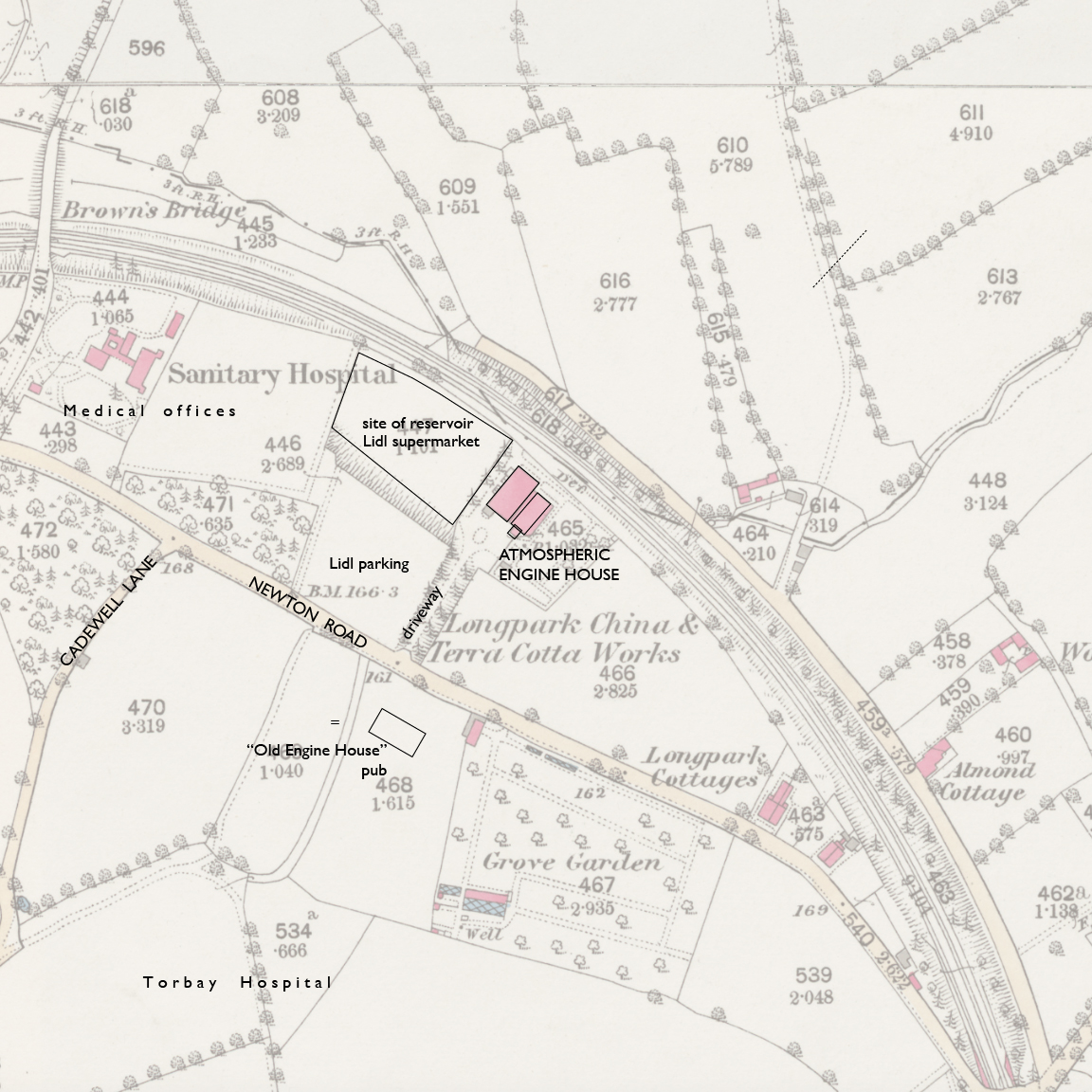
— Torquay, Ordnance Survey 25-inch, 1890. CC BY-NC-SA 4.0 courtesy National Library of Scotland.
Annotations by Joseph Brennan.
Upper left on the map: I think whenever I need a hospital, I want a sanitary one. I hope there is not another kind. I found an explanation, and a creative use of colons, quoted in "Torquay History" on a site called Forebears:
The Sanitary Hospital, erected by the Torquay Corporation, for the reception of patients suffering from infectious diseases, occupies a site on the Newton road, and in Cockington parish: it was given by the late William Kitson esq. of Hengrave, who laid the foundation stone in 1882: the building is of red brick, from designs by Mrs. Ernest Turner, of London, and consists of two wards, arranged and furnished throughout according to the latest scientific principles; attached are two residences for the medical officers, curator and nurses.There are medical offices on the Sanitary site, not far from the large grounds of the Torbay Hospital south of the Newton Road. Brown's Bridge probably dates from the opening of the railway, providing continued access from the Newton Road to the lane running to the north edge of the map. There is a footbridge today at the location.
Torquay engine house has the distinction of being the most intact survivor. Starcross and Totnes are contenders, but only Torquay has the complete chimney. Even though the building is not in a town, it is at least on a main road, and somehow it found enough uses to be maintained in good order. Most notably, from 1883 to 1957 it was occupied by the Longpark Pottery company, under slightly varying names, like the name on the OS map, Longpark China and Terra Cotta Works. During that time the engine and boiler houses each had an enormous kiln protruding through the roof, but the roof was restored after 1957. In 2019 I found the engine house proper in use by an office supply company, and the boiler house and newer adjacent buildings by a distributor of vegetables and flowers.
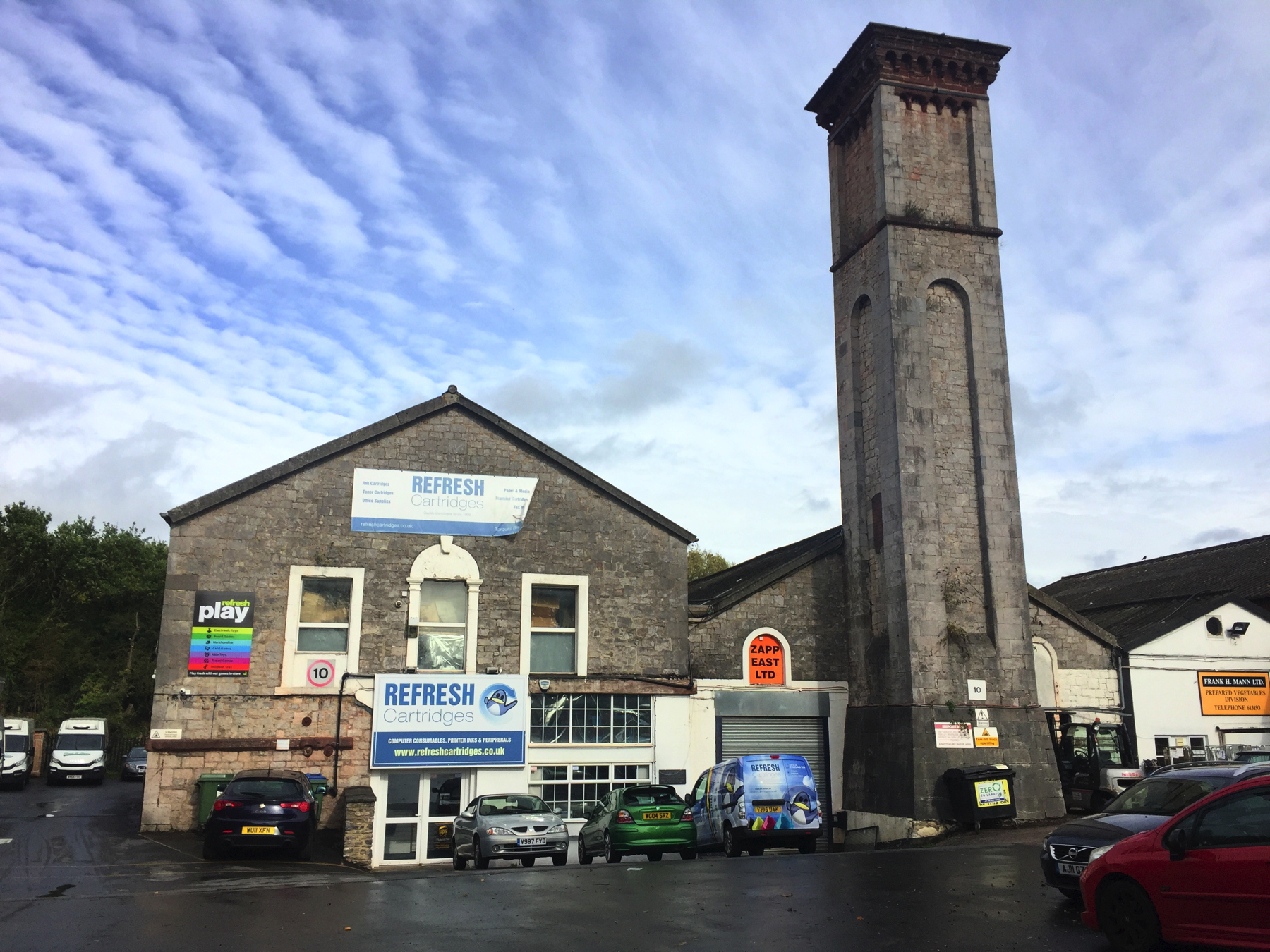
My picture above shows the street-side front of the buildings. The three windows in the engine house are in the original locations, and the two in the boiler house, while blocked up, are also still in place. Some changes were made to both at ground level.
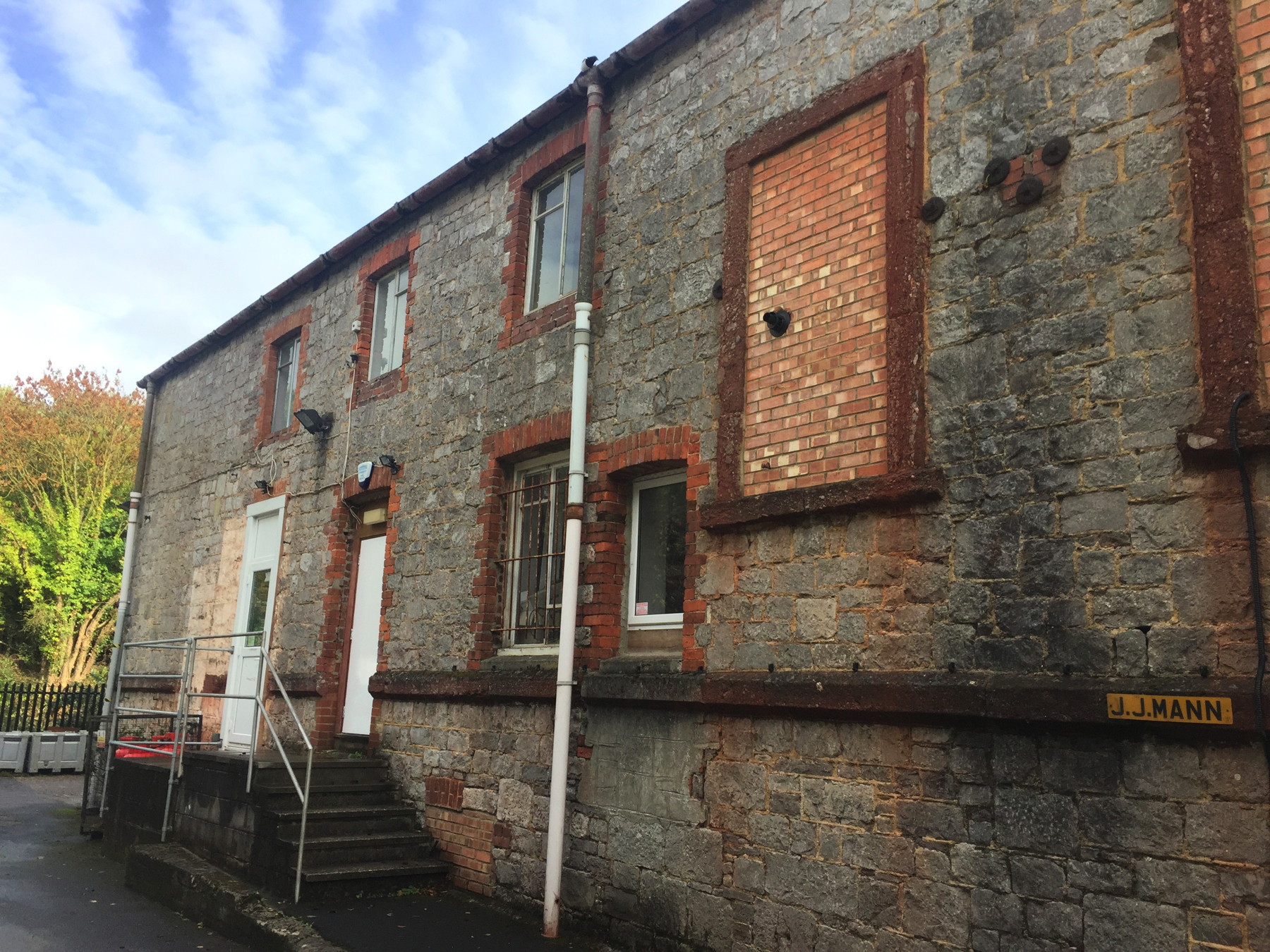
I walked around the left side of the engine house. My picture above shows the rear half of that side. The engines needed full height and would have been in the front half with the high windows that are now bricked up. The back half had two floors with three windows on the upper floor. On the lower floor we see two non-matching windows and probably an original door. The second door is newer and there are obvious alterations to the wall near it.
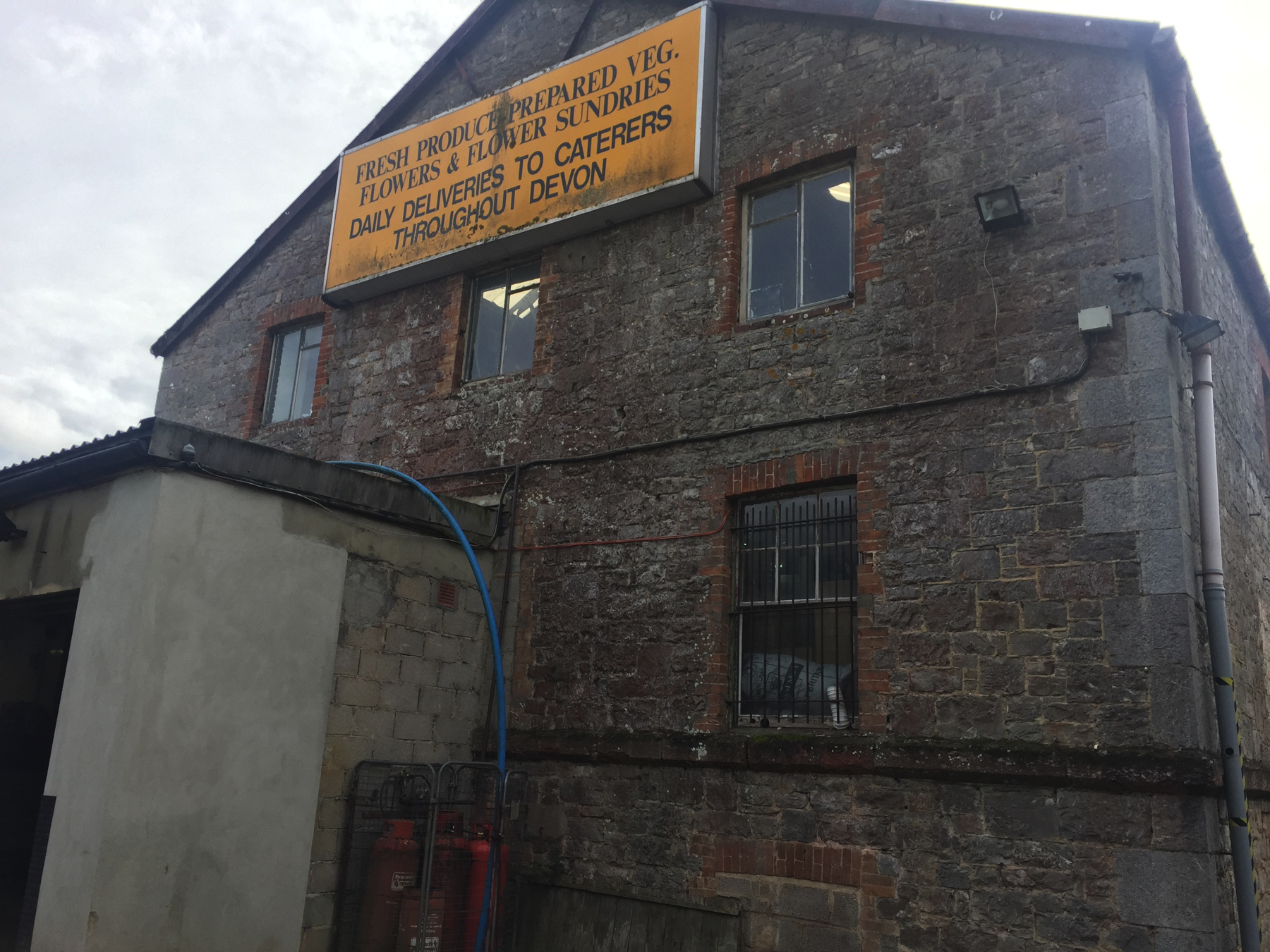
A shed has been added on the back wall. The tall door for installing machinery is either here and hidden by the shed, or was in the front on the right side where there are two rows of windows. The sign alerts railway passengers to the business next to the engine house. No one else can see it.
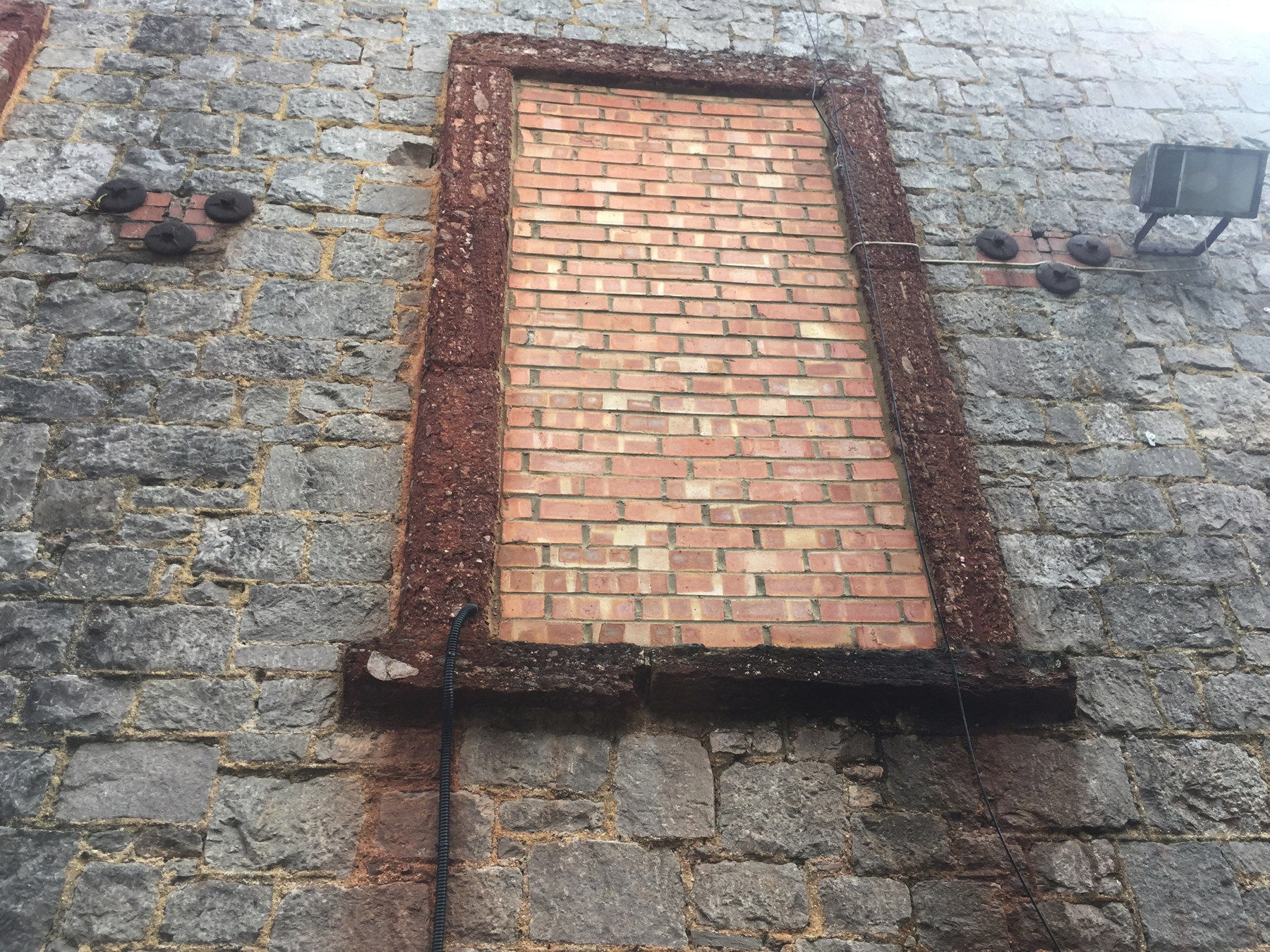
I took a close-up of one of the window openings on the side wall to show the usual deterioration of the red stone, like what we saw in my Starcross pictures.
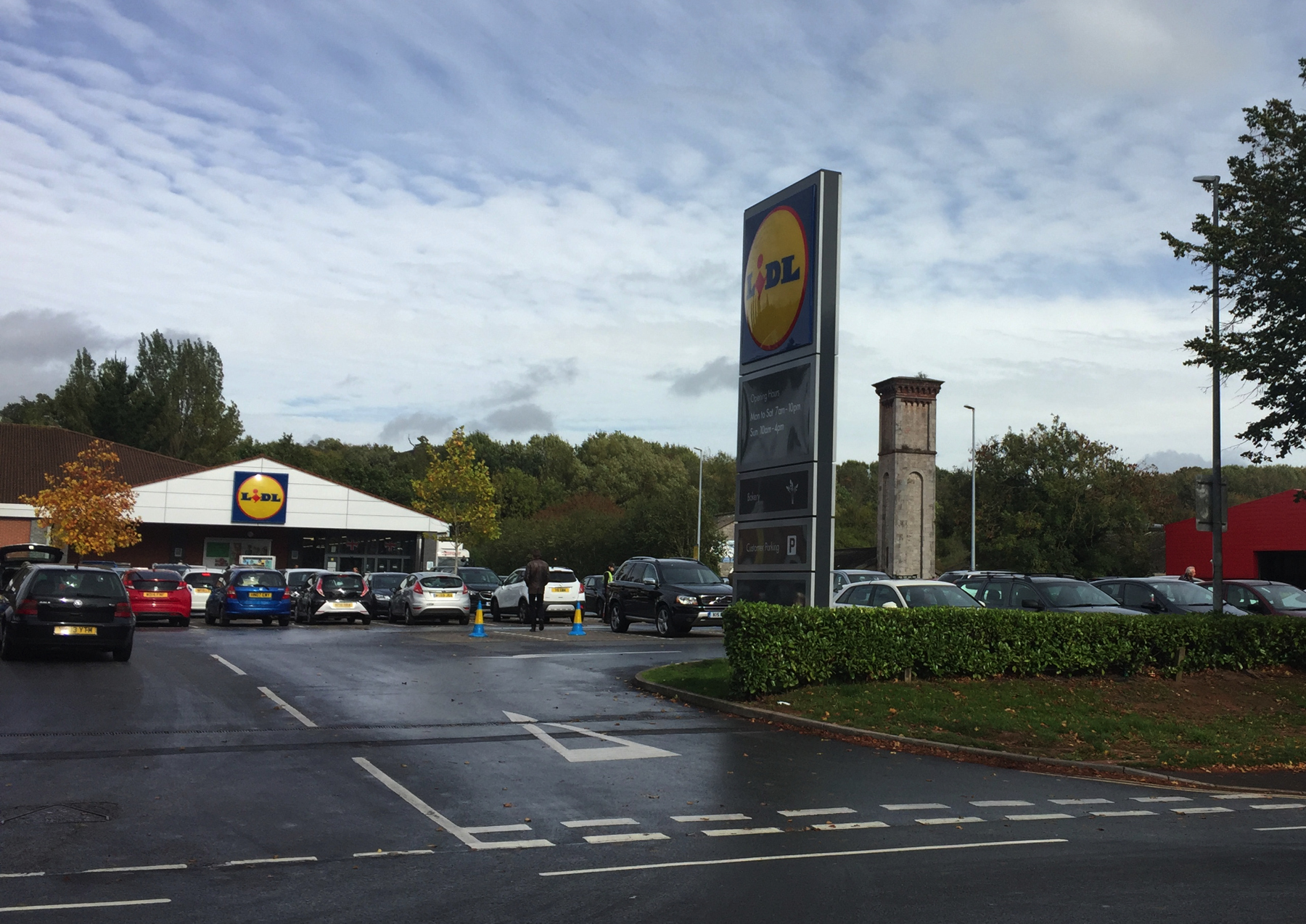
If you are going along the Newton Road, the chimney certainly marks the spot. The Lidl supermarket does too. It is on the site of the reservoir.
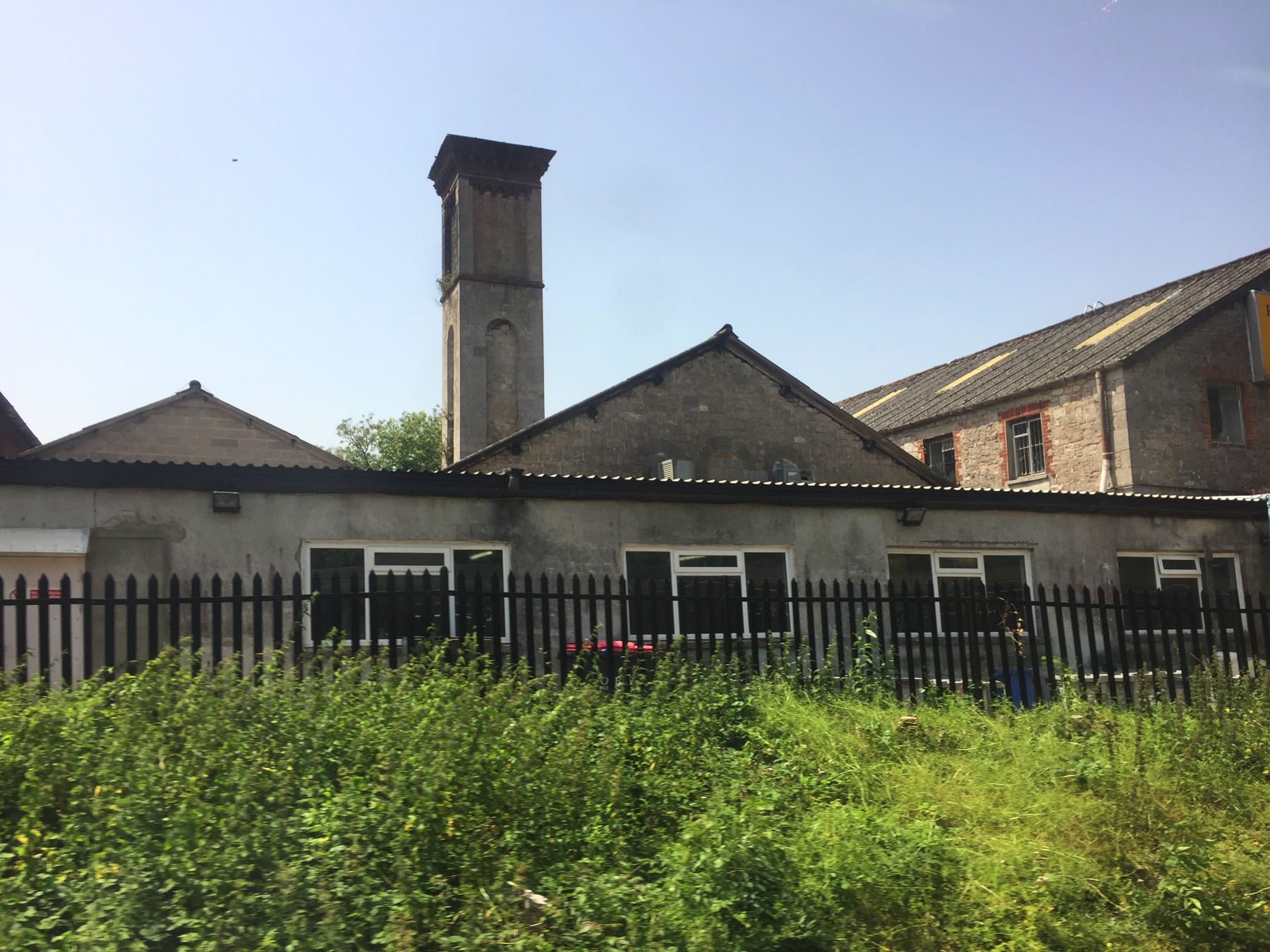
The photograph above is a lucky grab from a moving train. It looks like the boiler house had three windows high up on this side. There had to be large doors to bring in the boilers, and they are not on the street side, so they must have been on this side, hidden from view. The peaked-roof building on the left, and the low building blocking our view, are from various more recent dates.
Torre
The Torquay station of 1848 (now Torre) was not well located. An informative sign there tells us:
The route into the town was hotly disputed. There were conflicting plans, for example to run the railway in through St Marychurch and to run the line more directly to the harbour via the Belgrave Road area. Finally a terminus was agreed at a point well short of the town. It is said that the necessary land was sold to the railway company for £4000 by Sir Lawrence Palk so that he could remove himself to France to evade his creditors!The St Marychurch option would have brought the railway in way over east near Babbacombe, while the Belgrave Road option is closer to what was built later. The location at Torre nearly rules out the former.
Below are two pictures of the Torre station from the street side on a rainy day. (I think the shop sign reads "wanted for gash".)
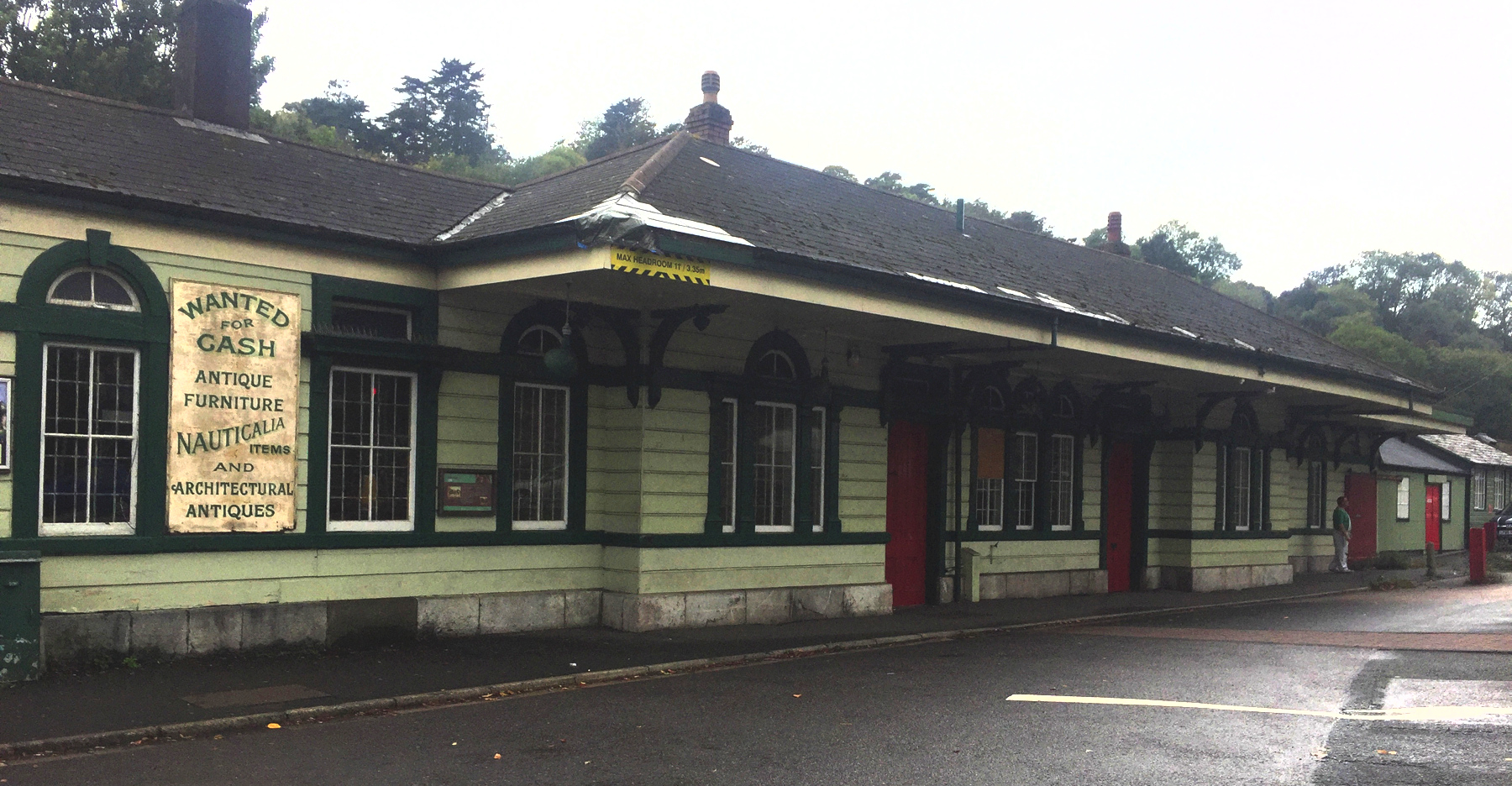
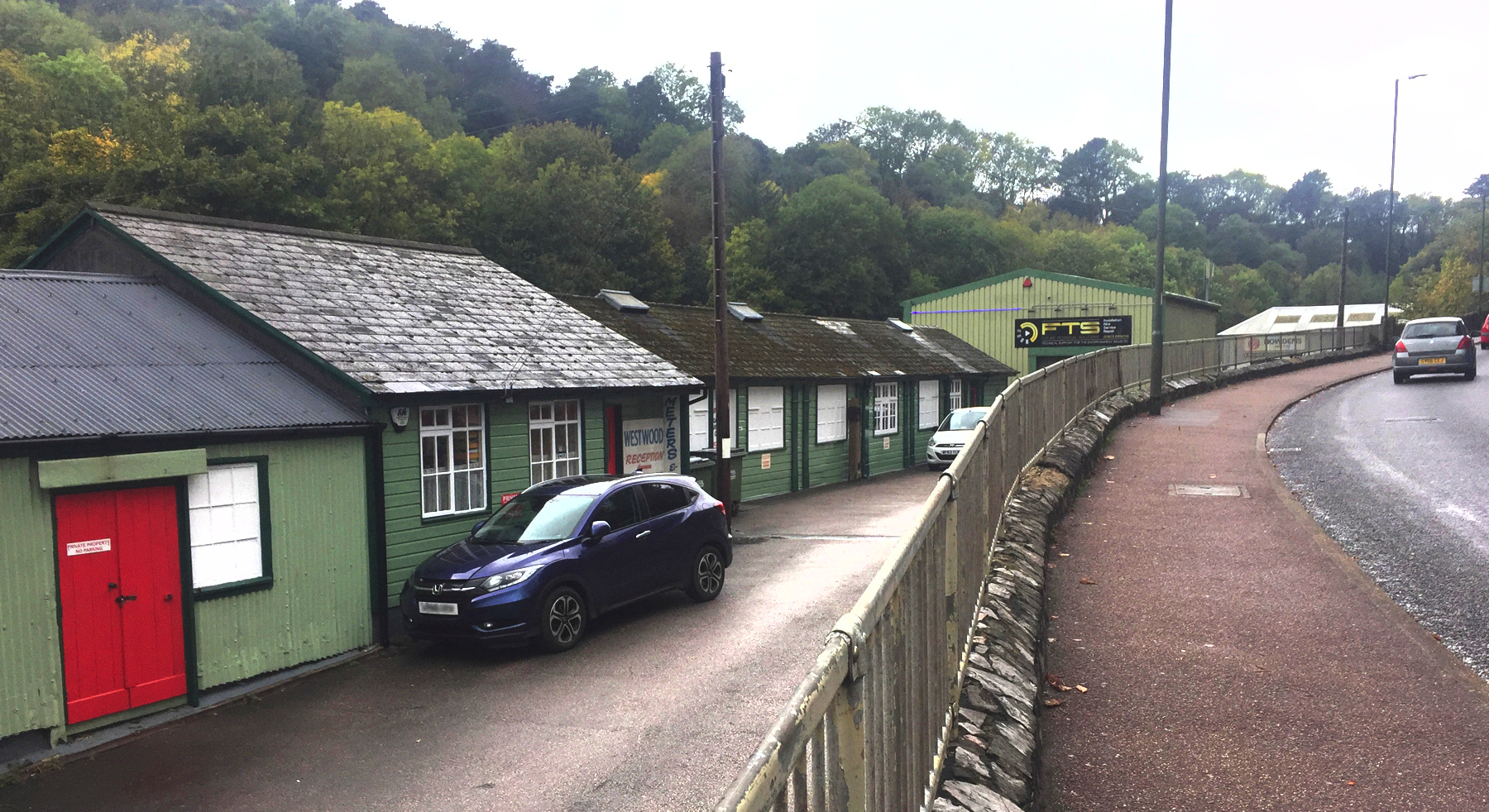
A photograph of the opening in December 1848 shows a station of the same type as others on the South Devon, namely passenger accommodation on the town side with a trainshed over one broad-gauge track. The station shown in my first picture is the larger replacement built in 1859 when the railway was extended farther south.
It is said that the 1848 station, minus the trainshed, is one of the small buildings in a line north of the "new" station. My guess is the middle building in the second photograph, behind the car. If the identification is correct, it is the only remaining part of a Brunel-era station of the South Devon Railway.
The same small building is the one with the white side wall in the view below from the down platform. I could have walked to the end and got a better view!
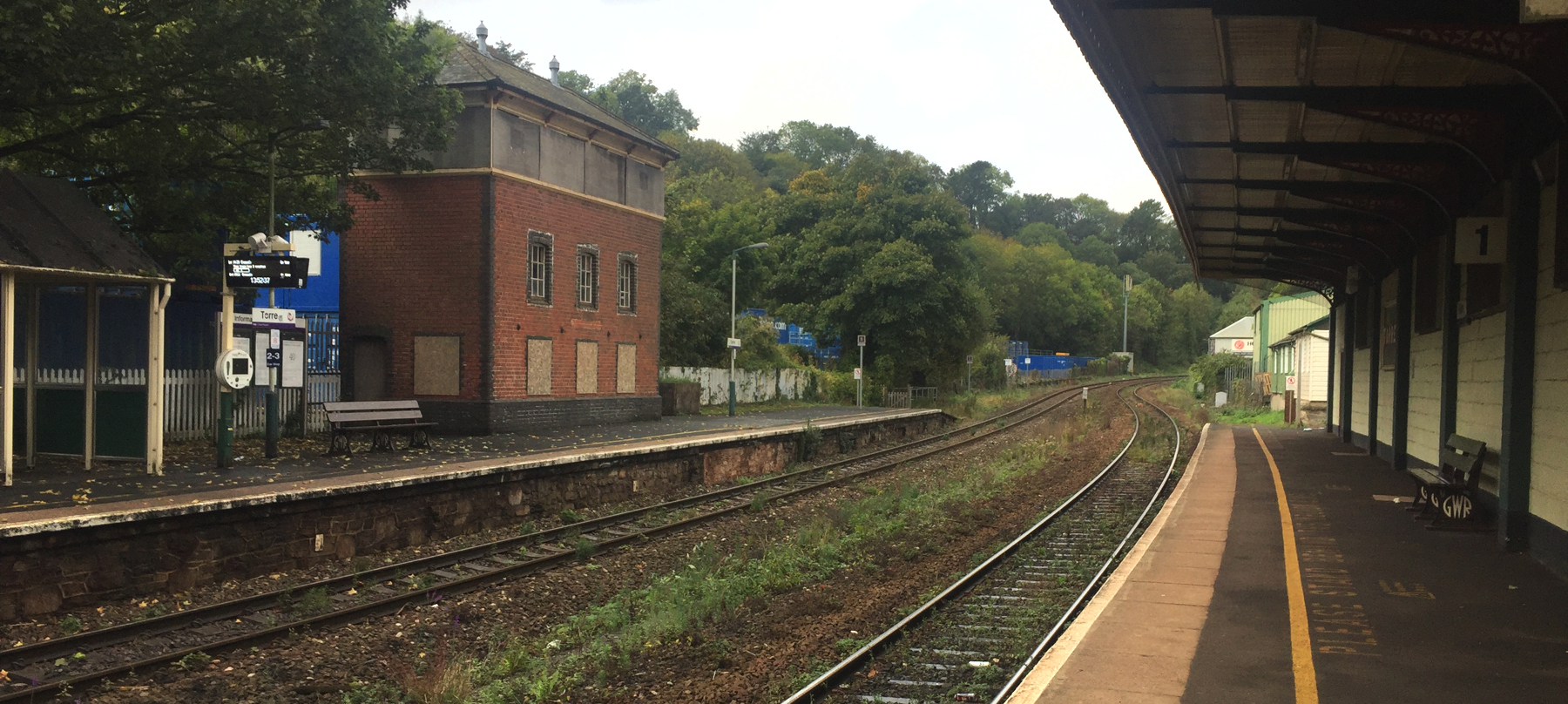
Kingswear and Dartmouth
The Torquay line was extended by the nominally separate Dartmouth and Torbay Railway, but it was operated by the South Devon Railway. The stations at Torquay (modern location) and Paignmouth were opened on 2 August 1859, and at that same date the 1848 Torquay station was given its present name of Torre. The line was completed to Dartmouth in 1864, although the track ended at Kingswear. From there passengers took a railway-owned ferry to Dartmouth, which was officially a railway station to and from which railway tickets were booked, even though no trains ever called there. For passengers it was like changing to and from a branch line at Kingswear, except that in this case the branch line was a boat.
Since 1972 Paignton has been the end of the line for National Rail franchises, but from a separate parallel station the heritage Dartmouth Steam Railway continues along the one-time Dartmouth and Torbay Railway to Kingswear, and the heritage railway includes the ferry to Dartmouth.